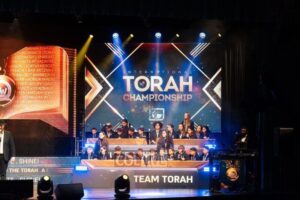The German novelist and dissident Thomas Mann wrote, “Everything is politics,” while screenwriter Aaron Sorkin offered, “Politics is perception.” Which is to say, so much of life hinges on the perception of those around us. All content-generators, from software engineers to journalists, must confront, in some fashion, the ways in which the words or images we put into the world are perceived.
Art is meant to be seen. Books are written to be read. A gift is not a gift until it’s received, and sometimes it’s received poorly.
In previous columns here and elsewhere, I’ve mused on the concept of a “New Jewish Neighborhood,” which some Jews and non-Jews have understood differently than I intended. The time has come to better elucidate what the New Jewish Neighborhood is by clarifying what it is not.
- The New Jewish Neighborhood is not a neighborhood for Jews. I’ve suggested (See: Make Baltimore Great Again) we should “… explore ways we might have deeper local impact by realizing Jewish values in heterogeneous context … To better inhabit our Jewishness we must be expansive in our concept of community.” I wish to challenge assumptions about Jewish neighborhoods whose measure has always been numbers of Jews and Jewish institutions. My hope is a New Jewish Neighborhood is one measured by Jewish values lived, where the Jews of that neighborhood are concerned with the how’s and why’s of Jewish living. While I am thrilled to have Jewish neighbors in Reservoir Hill, I am under no illusion that our neighborhood will (or should) become a majority Jewish neighborhood again.
- The philosopher George Steiner suggests the Jew’s mission is to be “the guest of humanity.” (See: He may be our greatest Jewish Thinker...) I differ with Steiner in that I believe it critical there be national homeland for the Jewish people as we, like other nations of the world, exercise our right to self-determination. But Israel isn’t an excuse for Jewish parochialism or triumphalism. For generations, our people have been shaped by our minority presence in other people’s lands as, indeed, we have by our aspiration for political sovereignty.
- The New Jewish Neighborhood is meant to articulate a new vision for Jews and Jewry, not to impose Jewishness on others. Save for a brief and regretful period during the Hasmonean dynasty, Jews have never been a proselytizing people. One need not believe in our God to be saved; we have no monopoly on virtue. Not long after I coined the phrase New Jewish Neighborhood, it became apparent that such a framing is useful as an invitation to (or polemic for) my fellow Jews. Once we began reaching out to our broader non-Jewish and largely non-white community in Reservoir Hill, we needed different nomenclature reflecting a shared set of aims and principles. Hence, IFO (See: inforof.org/) ) (In, For, Of) was born.
- The New Jewish Neighborhood is not only about race, but it is about race. We cannot appreciate Jewish urban/suburban migration without understanding racism and how Jews fit in. As neighborhoods transitioned from white to black, it was often Jews who played the relay. Understanding Jewishness in America today is to grasp the complex and evolving relationship between Jewishness and whiteness (at least for the 80 percent of Jews who are not black, brown or Sephardic). Race is a social construct, but those of us who look white cannot wish our whiteness away any more than African-Americans can their blackness. The New Jewish Neighborhood is where we stop wishing or pretending and start listening and doing.
- The Neighborhood cannot be located (only) on a map. On one hand, it is a neighborhood, a place where actual Jews, with intension and self-awareness, live with majority non-Jewish neighbors. (This is not Philip Roth’s “Eli, the Fanatic,” in which assimilated Jews in a WASPy community feel ashamed of their Orthodox Jewish neighbors.) It is also my specific neighborhood of Reservoir Hill, a rare locale where a nearly 100-year-old synagogue building supports a thriving congregation in what has for decades been a black neighborhood.
But the New Jewish Neighborhood is also a state of mind. Or as I wrote a couple months ago in Jmore (See: A New Way to View Tzedakah), “The neighborhood is all about posture — how we are as much as who we are.” In this sense, any community with Jews can become a New Jewish Neighborhood and any Jew, no matter where s/he lives can be a New Jewish Neighbor, a better “guest of humanity.”
 Daniel Cotzin Burg is rabbi of Beth Am Synagogue in Reservoir Hill, where he lives with his wife, Rabbi Miriam Cotzin Burg, and their children, Eliyah and Shamir. This column and others also can be found on TheUrbanRabbi.org. Each month in Jmore, Rabbi Burg explores a different facet of The New Jewish Neighborhood, a place where Jewish community is reclaimed and Jewish values reimagined in Baltimore.
Daniel Cotzin Burg is rabbi of Beth Am Synagogue in Reservoir Hill, where he lives with his wife, Rabbi Miriam Cotzin Burg, and their children, Eliyah and Shamir. This column and others also can be found on TheUrbanRabbi.org. Each month in Jmore, Rabbi Burg explores a different facet of The New Jewish Neighborhood, a place where Jewish community is reclaimed and Jewish values reimagined in Baltimore.





